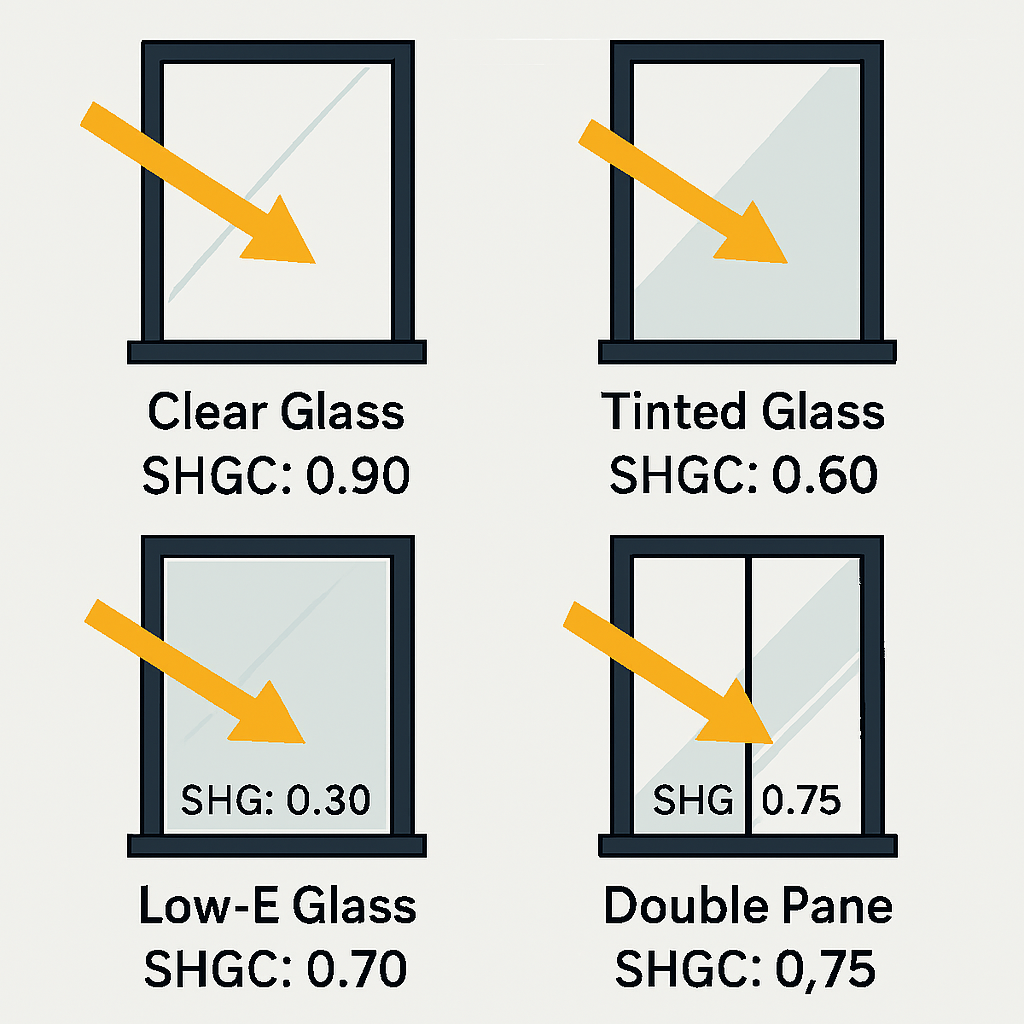Chapter 6 Sustainabilty and Engineering: Windown Transmittance#
1. Introduction#

Fig. 41 **Figure 6.8 **: Glass Transmittance#
Window Transmittance Analysis: Theoretical Overview#
1. Solar Heat Gain Coefficient (SHGC)#
Definition:
The Solar Heat Gain Coefficient (SHGC) is the fraction of incident solar radiation that passes through a window and contributes to indoor heat gain.
Range:
SHGC values range from 0 to 1.
A higher SHGC means more solar heat enters the building.
Application:
Used to calculate heat transmitted through the window:

2. Visible Transmittance (VT)#
Definition:
Visible Transmittance (VT) is the fraction of visible light that passes through a window.
Range:
VT values range from 0 to 1.
A higher VT means more daylight enters the space.
Application:
Used to calculate light transmitted through the window:
3. Cooling Cost Estimation#
Objective:
Estimate the energy cost associated with cooling the indoor space due to solar heat gain.
Assumptions:
1 W/m² over 1 hour ≈ 0.001 kWh/m²
Cooling cost rate = $0.12 per kWh
Formula:
4. Room-Specific Recommendations#
Based on Light Transmittance:
>600 lumens/m² → Ideal for sunrooms, studios, or high daylight spaces
400–600 lumens/m² → Suitable for living rooms, kitchens, or general use
<400 lumens/m² → Best for bedrooms, storage, or low-light areas
Based on Heat Transmittance:
<300 W/m² → Energy-efficient, minimal cooling load
300–500 W/m² → Moderate heat gain, may need shading
>500 W/m² → High heat gain, increased cooling costs
5. Comparative Analysis#
The calculator compares all window types under the same input conditions to help users select the most efficient option for their climate and room type.
Output Table Includes:
Window type
Heat transmitted (W/m²)
Light transmitted (lumens/m²)
🔍 Summary#
This method provides a simplified yet effective way to evaluate window performance in terms of:
Thermal comfort
Daylight availability
Energy cost implications
It supports informed decision-making for residential window selection based on climate, orientation, and room function.
2. Simulation#
import numpy as np
import pandas as pd
import matplotlib.pyplot as plt
from ipywidgets import interact, FloatSlider, Dropdown
# 📋 Window types and properties
window_types = {
"Clear Glass": {"SHGC": 0.85, "VT": 0.90},
"Tinted Glass": {"SHGC": 0.40, "VT": 0.60},
"Low-E Glass": {"SHGC": 0.30, "VT": 0.70},
"Double Pane": {"SHGC": 0.55, "VT": 0.75},
"Triple Pane": {"SHGC": 0.35, "VT": 0.65}
}
# ⚙️ Constants
cooling_cost_per_kwh = 0.12 # USD per kWh
# 📊 Interactive function
def transmittance_calculator(window, solar, visible):
data = window_types[window]
heat = solar * data["SHGC"]
light = visible * data["VT"]
cost = (heat / 1000) * cooling_cost_per_kwh
print(f"\n🔍 Results for {window}:")
print(f"🔆 Heat Transmitted: {heat:.2f} W/m²")
print(f"💡 Light Transmitted: {light:.2f} lumens/m²")
print(f"💰 Cooling Cost (1 hr): ${cost:.2f}/m²")
# 🧠 Interpretation
interpretation = []
interpretation.append("📘 Interpretation:")
if heat < 300:
interpretation.append("✅ Low heat gain — good for cooling efficiency.")
elif heat < 500:
interpretation.append("⚠️ Moderate heat gain — may require shading.")
else:
interpretation.append("❌ High heat gain — could increase cooling costs.")
if light > 600:
interpretation.append("✅ High daylight — ideal for sunrooms or studios.")
elif light > 400:
interpretation.append("⚠️ Moderate daylight — suitable for living rooms.")
else:
interpretation.append("❌ Low daylight — better for bedrooms or storage.")
print("\n" + "\n".join(interpretation))
# 📊 Comparison table
print("\n📊 Comparison of All Window Types:")
print(f"{'Window':<15} {'Heat (W/m²)':>15} {'Light (lumens/m²)':>25}")
print("-" * 55)
for name, props in window_types.items():
h = solar * props["SHGC"]
l = visible * props["VT"]
print(f"{name:<15} {h:>15.2f} {l:>25.2f}")
# 🧪 UI sliders and dropdown
interact(
transmittance_calculator,
window=Dropdown(options=list(window_types.keys()), description="Window Type"),
solar=FloatSlider(value=800, min=100, max=1200, step=50, description="Solar (W/m²)"),
visible=FloatSlider(value=750, min=100, max=1200, step=50, description="Visible (lumens/m²)")
)
<function __main__.transmittance_calculator(window, solar, visible)>
3. Self-Assessment#
📘 Conceptual Questions#
These questions explore the physical principles and modeling logic behind the calculator.
Solar Heat Gain Coefficient (SHGC)#
What does the SHGC represent in terms of energy transmission through windows?
How does SHGC affect indoor temperature and cooling load?
Why is SHGC multiplied by solar radiation to estimate transmitted heat?
Visible Transmittance (VT)#
What does VT measure in the context of window performance?
How does VT influence natural lighting and visual comfort?
Why might a window with high VT be desirable in certain rooms but not others?
Energy Cost Estimation#
How is the cooling cost estimated from transmitted heat?
What assumptions are made about energy pricing and cooling duration?
Why is the heat value converted to kilowatt-hours before calculating cost?
🔍 Reflective Questions#
These questions encourage critical thinking and application to real-world building design.
Which window type would you choose for a sunroom in a hot climate, and why?
How would the results change if the solar radiation input were based on seasonal averages?
What trade-offs exist between maximizing daylight and minimizing heat gain?
How could this model be extended to include window orientation or shading devices?
How might energy cost estimates vary across regions with different electricity rates?
❓ Quiz Questions#
Multiple Choice#
Which window type has the highest SHGC value?
A. Tinted Glass
B. Low-E Glass
C. Clear Glass
D. Triple Pane
Answer: CIf solar radiation is 800 W/m² and SHGC is 0.40, what is the transmitted heat?
A. 320 W/m²
B. 400 W/m²
C. 480 W/m²
D. 640 W/m²
Answer: AWhich factor most directly affects the amount of daylight entering a room?
A. SHGC
B. Cooling cost
C. VT
D. Solar radiation
Answer: C
True/False#
A window with low SHGC and high VT is ideal for reducing cooling costs while maintaining daylight.
Answer: TrueThe calculator assumes a constant cooling cost per kilowatt-hour.
Answer: TrueVisible transmittance affects the thermal load of a building.
Answer: False
Short Answer#
Explain why a window with high SHGC might be problematic in a warm climate.
Answer: It allows more solar heat to enter, increasing indoor temperatures and cooling demand.What physical factors might cause actual heat gain to differ from the model’s estimate?
Answer: Window orientation, shading, frame material, and air leakage can all influence real-world performance.


